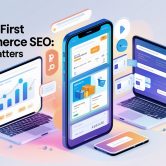The digital landscape is evolving at lightning speed, and businesses today cannot afford outdated websites. In 2025, AI-powered website design and development has become the new benchmark for building digital experiences that are not only beautiful but also intelligent, responsive, and data-driven. From AI-driven UX enhancements to predictive analytics, artificial intelligence is redefining how websites are built, optimized, and maintained.
In this blog, we’ll explore how AI is shaping the future of Website Design & Development, focusing on four key areas: AI-driven UX, personalization, predictive analytics, and smart design tools.
If you’re planning to build or redesign your business website, make sure you explore our Website Design & Development services to stay ahead of the competition.
AI-Driven UX: Creating Seamless Digital Experiences
User experience (UX) has always been at the heart of web design, but AI takes it to a whole new level. Instead of relying solely on manual testing or guesswork, AI-driven UX analyzes massive amounts of user data to understand behavior patterns, click flows, and interaction points.
- Dynamic Interfaces: AI can adapt interfaces in real-time depending on how users interact with the site. For example, navigation menus can rearrange themselves to highlight frequently used sections.
- Accessibility Enhancements: Tools powered by AI detect accessibility issues, such as poor color contrasts or missing alt text, and provide instant fixes.
- Continuous Feedback Loops: Instead of periodic usability testing, AI can run ongoing usability analysis, ensuring websites evolve as user needs change.
By leveraging AI-driven UX, businesses in 2025 are building websites that feel intuitive, reduce bounce rates, and maximize conversions.

Personalization: Every Visitor Gets a Tailored Journey
In 2025, personalization has shifted from “nice-to-have” to “non-negotiable.” Customers expect websites to understand their needs the same way streaming platforms recommend shows or ecommerce stores suggest products.
AI makes personalization possible at scale:
- Content Recommendations: Visitors see articles, products, or services tailored to their browsing history and intent.
- Localized Experiences: AI delivers language, currency, and even cultural design elements depending on the user’s region.
- Behavior-Based Personalization: If a visitor lingers on pricing pages, AI may highlight limited-time offers to push conversions.
This level of personalization turns websites into revenue engines, guiding each user through a journey that feels natural and uniquely relevant. Businesses investing in Website Design & Development with AI personalization are already seeing higher engagement and stronger brand loyalty.
Predictive Analytics: Designing for Tomorrow’s Users
One of AI’s greatest strengths is its ability to look ahead. Predictive analytics allows websites to anticipate user behavior before it happens, giving businesses a competitive edge.
- Forecasting Conversions: AI models analyze user patterns to predict who is likely to convert and adjust the website experience accordingly.
- Proactive Support: Chatbots powered by predictive AI can anticipate customer queries based on browsing behavior and provide solutions before visitors even ask.
- Trend-Driven Design Decisions: Instead of reacting to design fads after they peak, predictive analytics helps brands adjust layouts, visuals, and functionality in real-time, aligned with upcoming trends.
By using predictive analytics, businesses are no longer reactive. They’re building websites that evolve ahead of the market, setting a higher standard for digital presence.
Smart Design Tools: Faster, Smarter, Better Websites
Traditionally, website design was time-consuming, requiring long hours of coding, prototyping, and revisions. Today, AI-powered smart design tools accelerate the process while maintaining quality.
- AI Website Builders: Platforms use machine learning to auto-generate layouts, color schemes, and even typography based on brand guidelines.
- Content Automation: AI tools create blog drafts, meta descriptions, and even SEO tags aligned with search trends.
- Testing & Optimization: AI runs automated A/B tests across multiple design variations and instantly implements the highest-performing version.
- Code Assistance: AI-driven coding assistants help developers identify bugs, optimize code, and suggest improvements in real-time.
These smart tools mean websites can be launched faster, optimized more effectively, and updated without extensive manual effort.
Conclusion
AI is no longer a buzzword, it’s the engine powering the next generation of Website Design & Development. From improving UX with adaptive interfaces to creating hyper-personalized experiences, predicting future user needs, and streamlining workflows with smart design tools, AI has become essential in building high-performance websites.
For businesses in 2025, the question isn’t whether to adopt AI in web development, but how quickly they can embrace it to stay competitive.
Ready to future-proof your website? Explore our Website Design & Development solutions and see how AI-driven strategies can transform your online presence.




